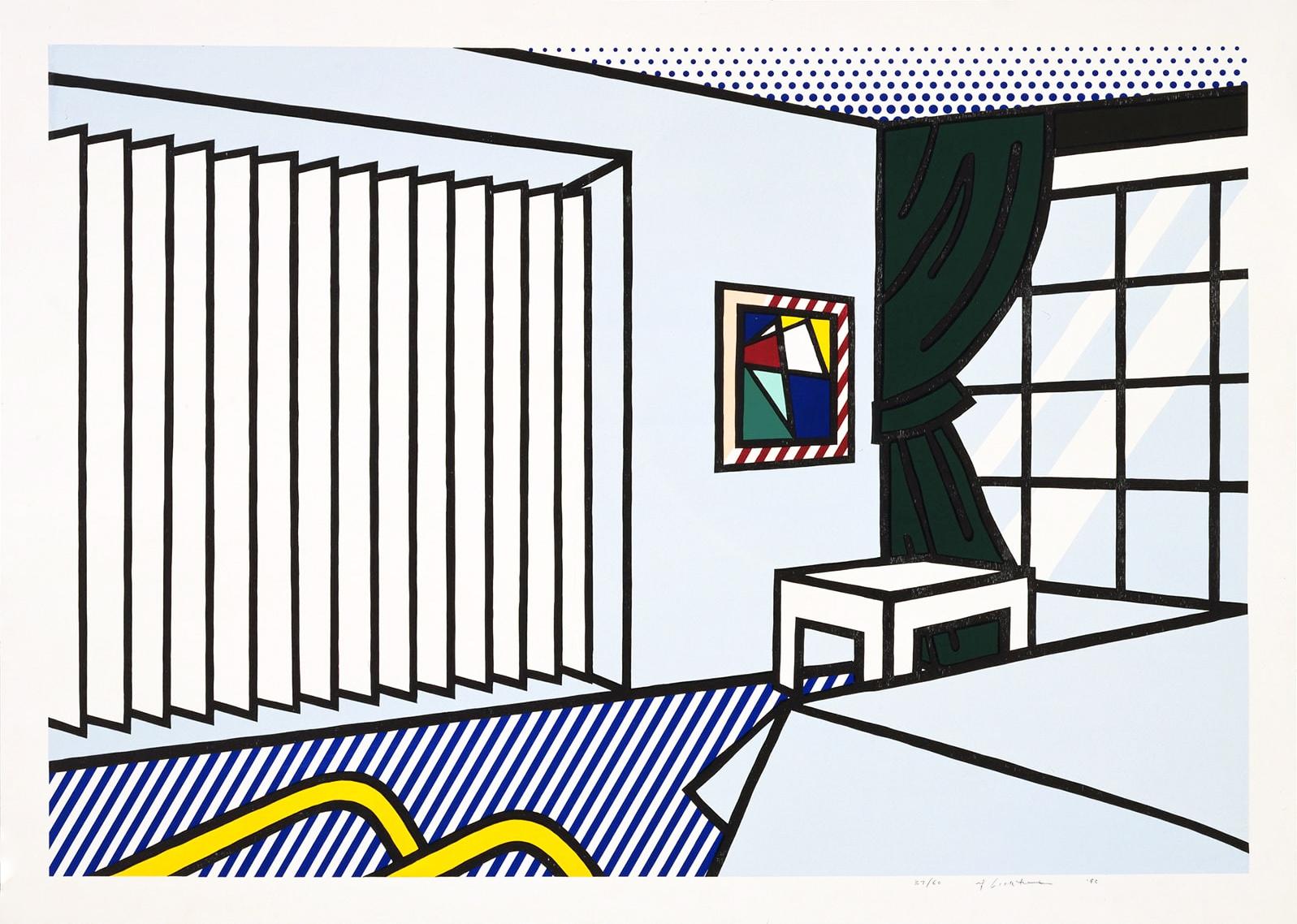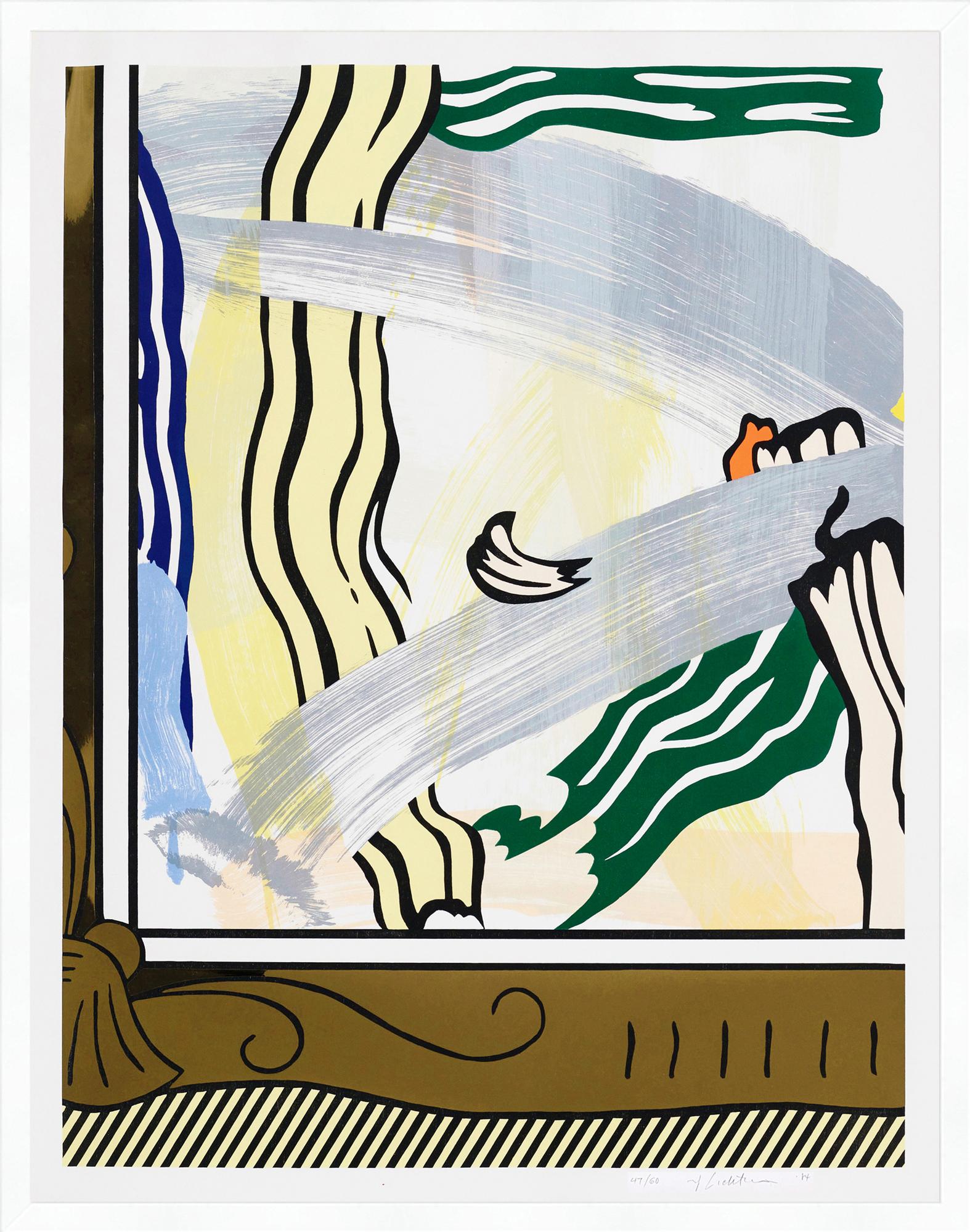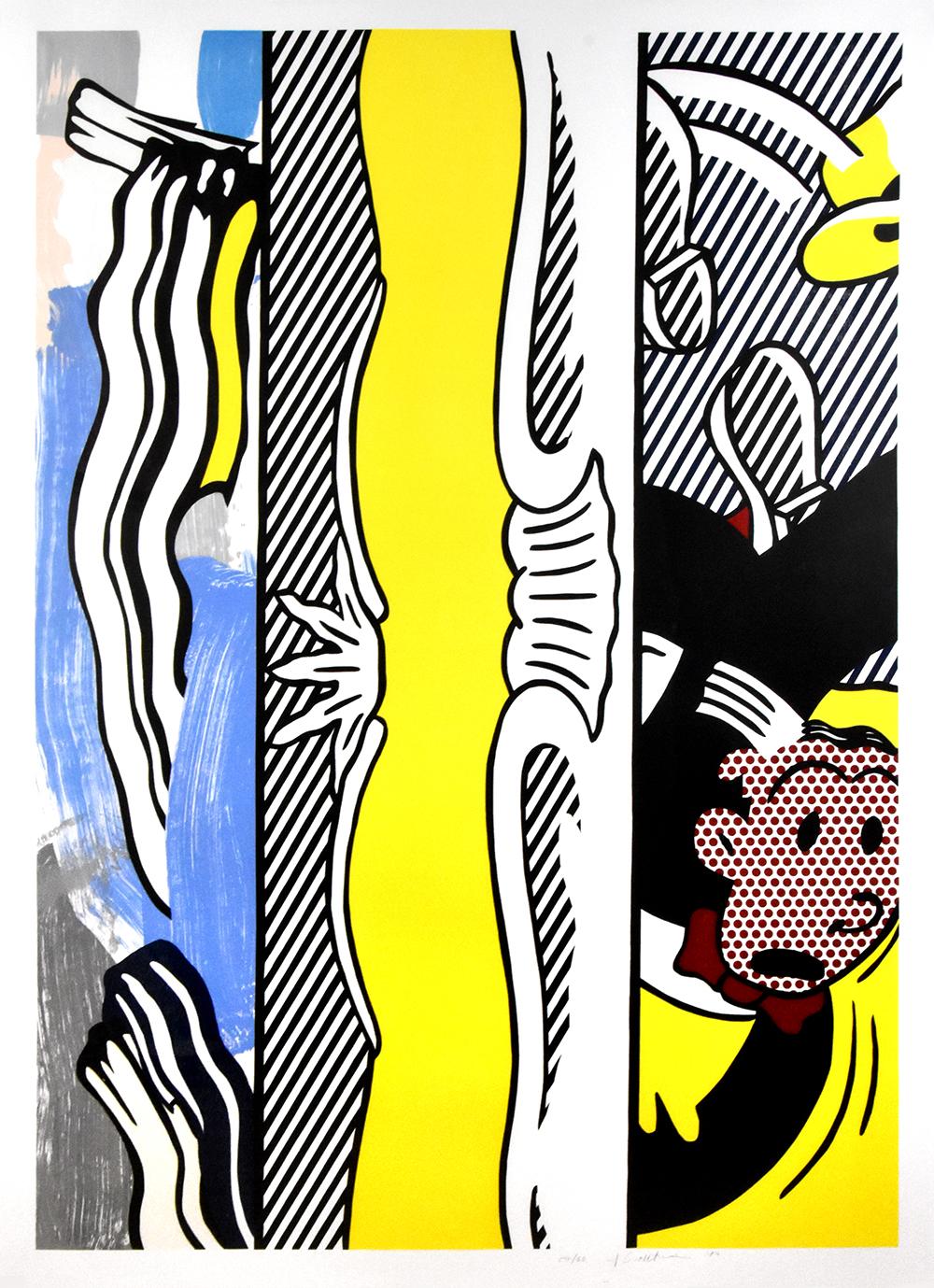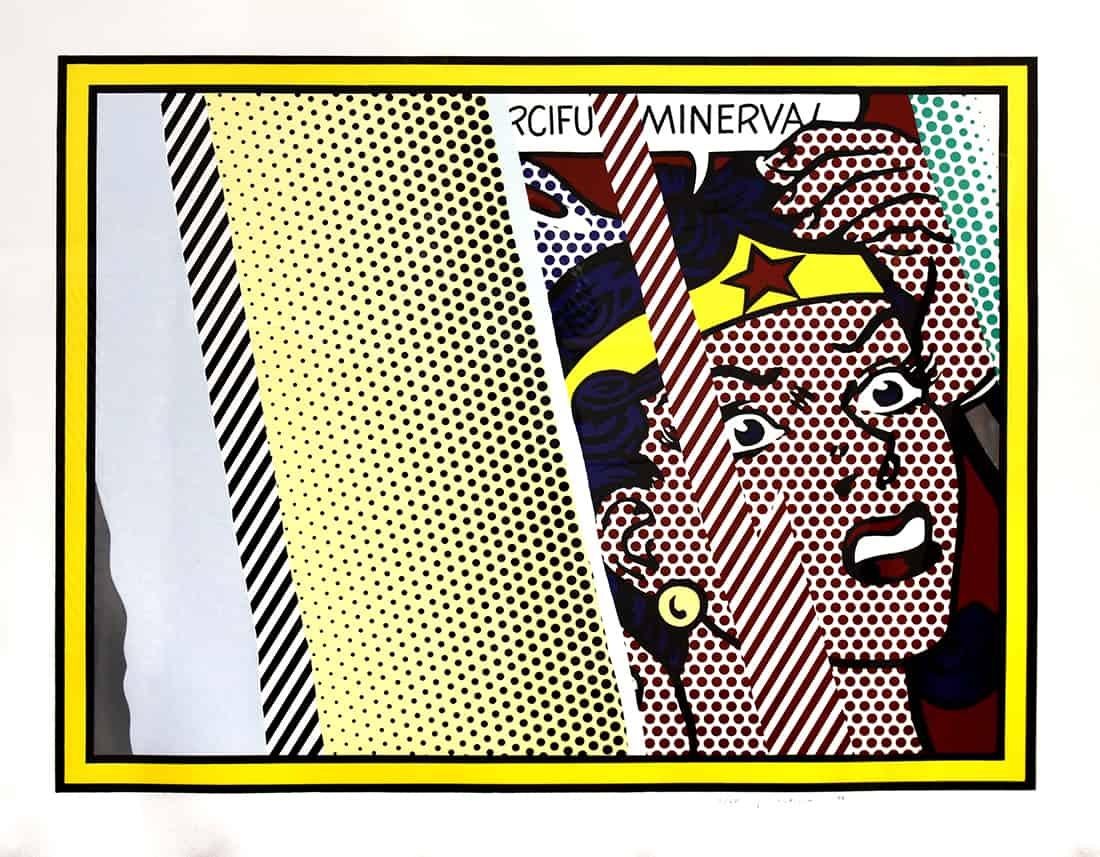Roy LichtensteinReflections on Brushstrokes, from the Reflections Series1990
1990
About the Item
- Creator:Roy Lichtenstein (1923 - 1997, American)
- Creation Year:1990
- Dimensions:Height: 57.13 in (145.12 cm)Width: 71 in (180.34 cm)
- Medium:
- Movement & Style:
- Period:
- Condition:
- Gallery Location:Palo Alto, CA
- Reference Number:
Roy Lichtenstein
Roy Lichtenstein is one of the principal figures of the American Pop art movement, along with Andy Warhol, James Rosenquist, Claes Oldenburg and Robert Rauschenberg.
Drawing inspiration from comic strips, Lichtenstein appropriated techniques commercial printing in his paintings, introducing a vernacular sensibility to the visual landscape of contemporary art. He employed visual elements such as the halftone dots that comprise a printed image, and a comic-inspired use of primary colors gave his paintings their signature “Pop” palette.
Born and raised in New York City, Lichtenstein enjoyed Manhattan’s myriad cultural offerings and comic books in equal measure. He began painting seriously as a teenager, studying watercolor painting at the Parsons School of Design in the late 1930s, and later at the Art Students League, where he worked with American realist painter Reginald Marsh. He began his undergraduate education at Ohio State University in 1940, and after a three-year stint in the United States Army during World War II, he completed his bachelor’s degree and then his master’s in fine arts. The roots of Lichtenstein’s interest in the convergence of high art and popular culture are evident even in his early years in Cleveland, where in the late 1940s, he taught at Ohio State, designed window displays for a department store and painted his own pieces.
Working at the height of the Abstract Expressionist movement in the 1950s, Lichtenstein deliberately eschewed the sort of painting that was held in high esteem by the art world and chose instead to explore the visual world of print advertising and comics. This gesture of recontextualizing a lowbrow image by importing it into a fine-art context would become a trademark of Lichtenstein’s artistic style, as well as a vehicle for his critique of the concept of good taste. His 1963 painting Whaam! confronts the viewer with an impact scene from a 1962-era issue of DC Comics’ All American Men of War. Isolated from its larger context, this image combines the playful lettering and brightly colored illustration of the original comic with a darker message about military conflict at the height of the Cold War. Crying Girl from the same year featured another of Lichtenstein’s motifs — a woman in distress, depicted with a mixture of drama and deadpan humor. His work gained a wider audience by creating a comic-inspired mural for the New York State Pavilion of the 1964 World's Fair, he went on to be represented by legendary New York gallerist Leo Castelli for 30 years.
In the 1970s and ’80s, Lichtenstein experimented with abstraction and began exploring basic elements of painting, as in this 1989 work Brushstroke Contest. In addition to paintings in which the brushstroke itself became the central subject, in 1984 he created a large-scale sculpture called Brushstrokes in Flight for the Port Columbus International Airport in Ohio. Still Life with Windmill from 1974 and the triptych Cow Going Abstract from 1982 both demonstrate a break from his earlier works where the subjects were derived from existing imagery. Here, Lichtenstein paints subjects more in line with the norms of art history — a pastoral scene and a still life — but he has translated their compositions into his signature graphic style, in which visual elements of printed comics are still a defining feature.
Lichtenstein’s work is represented in the collections of the Metropolitan Museum of Art, the Museum of Modern Art, Tate Modern, and many others. He was awarded National Medal of Arts in 1995, two years before he passed away.
Find a collection of Roy Lichtenstein prints, drawings and more on 1stDibs.
- ShippingRetrieving quote...Ships From: Palo Alto, CA
- Return PolicyA return for this item may be initiated within 7 days of delivery.
- Nude, from Brushstroke Figures SeriesBy Roy LichtensteinLocated in Palo Alto, CARoy Lichtenstein Nude, from Brushstroke Figures Series, 1989 is a marvelous work that features Lichtenstein’s loose, freely Expressionistic brushstrokes combined with diagonal stripe...Category
1980s Pop Art Figurative Prints
MaterialsLithograph, Wax, Screen, Woodcut
- Two Paintings: DagwoodBy Roy LichtensteinLocated in Palo Alto, CARoy Lichtenstein Two Paintings: Dagwood, 1984 is a vivid, colorful piece that demonstrates the clever work of Lichtenstein’s varied oeuvre. The work is c...Category
1980s Pop Art Figurative Prints
MaterialsWoodcut, Lithograph
- Reflections on Minerva, from ReflectionsBy Roy LichtensteinLocated in Palo Alto, CAFramed in a bright yellow boarder, Roy Lichtenstein Reflections on Minerva, from Reflections, 1990 shows a distressed Minerva partially obscured by reflective lines. As if she is beh...Category
1990s Pop Art Figurative Prints
MaterialsLithograph, Screen
- Apple and LemonBy Roy LichtensteinLocated in Palo Alto, CARoy Lichtenstein Apple and Lemon, 1983 is an excellent example of the artist’s later work. Lichtenstein largely abandoned his famous comic strip pan...Category
1980s Pop Art Still-life Prints
MaterialsWoodcut, Handmade Paper
- Plains Indian Shield, From the Cowboys and Indians SeriesBy Andy WarholLocated in Palo Alto, CACreated in 1986, this color screenprint on Lenox Museum Board is hand signed by Andy Warhol (Pennsylvania, 1928 - New York, 1987) in pencil in the lower left. A unique work inscribed ‘TP’ (trial proof) and numbered 7 from the edition of 36 unique trial proofs; aside from the edition of 250; published by Ronald Feldman Fine Arts, Inc., New York; printed by Rupert Jasen Smith, New York. Andy Warhol Cowboys and Indians Series: Andy Warhol’s Cowboys and Indians series of 1986 consists of ten prints each depicting their own respective subject—John Wayne, Annie Oakley, Kachina Dolls, Geronimo, Buffalo Nickel, Tonto, Theodore Roosevelt, General George Custer, Plains Indian Shield, and Northwest Coast Mask. Featuring images of famous American Western icons, Warhol’s series explores the relationship between Native Americans and Hollywood's portrayal of them in Western films. Warhol, being fascinated with celebrity culture, uses these famous figures to examine ways in which fame and popular culture intersect with history and myth. The Cowboys and Indians series was also created during a time at which Warhol was exploring his own Native American heritage. His mother was of Ruthenian and Carpatho-Rusyn descent, but Warhol claimed that his father was of Slovakian and Native American ancestry. Overall, the Cowboys and Indians series reflects Warhol's interest in American culture and history, as well as his fascination with celebrity and the intersection of art and commerce. This screenprint is part of a portfolio of works Warhol created in 1986 titled Cowboys and Indians. Other works in the Cowboys and Indians Series include General Custer, Sitting Bull, Kachina Dolls, Geronimo, Annie Oakley, War Bonnet Indian, Buffalo Nickel, Action Picture, Northwest Coast Mask, Plains Indians Shield, Mother and Child, Indian Head Nickel, and Teddy Roosevelt. Catalogue Raisonné: Andy Warhol Plains Indian Shield...Category
1980s Pop Art Figurative Prints
MaterialsScreen
- Nude Reading, from Nudes, 1994By Roy LichtensteinLocated in Palo Alto, CAIn Roy Lichtenstein Nude Reading, from Nudes, 1994, a woman comfortably lounges in her home, reading a book while devoid of clothes; derived in Lichtenstein’s classical style of high...Category
1990s Pop Art Figurative Prints
MaterialsScreen
- BEDROOMBy Roy LichtensteinLocated in Aventura, FLFrom Interior Series. Woodcut and screen print in colors on Museum Board. Hand signed, dated and numbered by Roy Lichtenstein. Published by Gemini G.E.L., Los Angeles.. Corlett 247...Category
1990s Pop Art Portrait Prints
MaterialsBoard, Lithograph, Screen, Woodcut
- Painting in Gold FrameBy Roy LichtensteinLocated in Aventura, FLFrom the Paintings series. Woodcut, Lithograph, screen print and collage on Arches 88 paper. Hand signed, dated and numbered by Roy Lichtenst...Category
1980s Pop Art Portrait Prints
MaterialsScreen, Paper, Lithograph, Woodcut
- Still Life with LobsterBy Roy LichtensteinLocated in Tallinn, EE”Still Life with Lobster”. Signed, dated and numbered rf Lichtenstein ’74 2/100. Lithograph and screenprint in colours, I. 81.7 x 78.8 cm, S....Category
1970s Pop Art Figurative Prints
MaterialsScreen, Lithograph
- Malcolm Morley 1969 Vintage British Pop Art Screenprint Lithograph Marine w FlagBy Malcolm MorleyLocated in Surfside, FLMalcolm Morley (British, b. 1931) Silkscreen screenprint Title: Marine Sergeant at Valley Forge Hand signed lower right. on BFK Rives paper. Provenance: Estate of Roger Prigent - Malmaison. (from Kornblee Gallery, photo of label but label is not included) Image: 19 1/4"H x 16" W; Sheet: 30 1/4"H x 22 1/2" W. Printer: Chiron Press (New York, NY) Date: 1969 Malcolm Morley (1931-2018) is an English artist now living in the United States. He is best known as a photorealist. Morley was born in north London. He had a troubled childhood—after his home was blown up by a bomb during the Blitz in World War II, his family was homeless for a time—and did not discover art until serving a three-year stint in Wormwood Scrubs prison. After release, he studied art first at the Camberwell School of Arts and then at the Royal College of Art (1955–1957), where his fellow students included Peter Blake and Frank Auerbach. In 1956, he saw an exhibition of contemporary American art at the Tate Gallery, and began to produce paintings in an abstract expressionist style. In the mid 1960s, Morley briefly taught at Ohio State University, and then moved back to New York City, where he taught at SUNY Stony Brook from 1970 through 1974 and the School of Visual Arts. In the early 1980s he was married to the Brazilian artist Marcia Grostein...Category
21st Century and Contemporary Pop Art Figurative Prints
MaterialsLithograph, Screen
- Joe Tilson British Pop Art Screenprint, Color Lithograph 4 Seasons 4 ElementsBy Joe TilsonLocated in Surfside, FLSilkscreen screenprint or Lithograph Hand signed and numbered. An esoteric, mystical, Kabbala inspired print with Hebrew as well as other languages. Joseph Charles Tilson RA (born 2...Category
1970s Pop Art Abstract Prints
MaterialsLithograph, Screen
- Still Life with Hans Maler Pop Art Serigraph Hand SignedBy Josef LeviLocated in Surfside, FLOn deckle edged watermarked Arches French paper. hand signed in pencil, dated and numbered. the edition size is 175. there are three states of the same image image each with increasing detail and color. This is just for the one in the photo. Josef Alan Levi (1938) is an American artist whose works range over a number of different styles, but which are unified by certain themes consistently present among them. Josef Levi began his artistic career in the 1960s and early '70s, producing highly abstract and very modernist pieces: these employing exotic materials such as light fixtures and metallic parts. By 1975, Levy had transitioned to painting and drawing still lifes. At first these were, traditionally, of mundane subjects. Later, he would depict images from art history, including figures originally created by the Old Masters. Around 1980, he made another important shift, this time toward creating highly precise, though subtly altered reproductions of pairs of female faces which were originally produced by other artists. It is perhaps this work for which he is most well known. Since around 2000, Josef Levi has changed the style of his work yet again: now he works entirely with computers, using digital techniques to abstract greatly from art history, and also from other sources. Levi's works of art in the collections of the Museum of Modern Art, NYC, the National Gallery of Art, and the Albright-Knox Museum, among many others. Levi's art has been featured on the cover of Harper's Magazine twice, once in June 1987, and once in May 1997. Josef Levi received a Bachelor of Arts degree in 1959 from the University of Connecticut, where he majored in fine arts and minored in literature. From 1959 to 1960, he served to a first lieutenant in the U.S. Army, and from 1960 through 1967 he was in the U.S. Army Reserves. In 1966, he received the Purchase Award from the University of Illinois in 1966, and he was featured in New Talent U.S.A. by Art in America. He was an artist in residence at Appalachian State University in 1969, taught at Farleigh Dickenson University in 1971 and was a visiting professor of art at Pennsylvania State University in 1977. From 1975 to 2007, Levi resided in New York City. He now lives in an apartment in Rome, where he is able to paint with natural light as he was unable in New York. From 1959 to 1960, Josef took some courses of Howard McParlin Davis and Meyer Schapiro at Columbia University which initiated him into the techniques of reproducing the works of the Old Masters. His first works, created in the 1960s, were wood and stone sculptures of women. His first mature works were abstract pieces, constructed of electric lights and steel. In 1970, Levi's materials included fluorescent light bulbs, Rust-Oleum and perforated metal in addition to paint and canvas. By 1980, Josef Levi's art had transformed into a very specific form: a combination of reproductions of female faces which were originally depicted by other artists. The faces which he reproduces may be derived from either portraits or from small portions of much larger works; they are taken from paintings of the Old Masters, Japanese ukiyo-e, and 20th-century art. Artists from whom he has borrowed include: Vermeer, Rembrandt, Piero della Francesca, Botero, Matisse, Utamaro, Correggio, Da Vinci, Picasso, Chuck Close, Max Beckmann, Pisanello, Lichtenstein. The creation of these works is informed by Levi's knowledge and study of art history. Josef Levi's paintings from this period are drawn, then painted on fine linen canvas on wooden stretchers. The canvas is coated with twenty-five layers of gesso in order to produce a smooth surface on which to work. The drawing phase takes at least one month. Levi seals the drawing with acrylic varnish, and then he may apply layers of transparent acrylic in order to approximate the look of old paintings. After the last paint is applied, another layer of acrylic varnish is sprayed on to protect the work. Most of the figures in his contemporary pieces are not paired with any others. SELECTED COLLECTIONS MUSEUM OF MODERN ART, NEW YORK, NY ALBRIGHT- KNOX GALLERY, BUFFALO, NY ALDRICH MUSEUM OF CONTEMPORARY ART, RIDGEFIELD, CT NATIONAL GALLERY OF ART, WASHINGTON, DC BROOKLYN MUSEUM OF ART, BROOKLYN, NY SMITHSONIAN NATIONAL MUSEUM OF AMERICAN HISTORY, WASHINGTON, DC CORCORAN GALLERY, WASHINGTON, DC UNIVERSITY OF NOTRE DAME ART...Category
1970s Pop Art Figurative Prints
MaterialsLithograph, Screen






